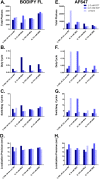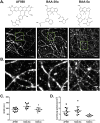Superresolution microscopy with novel BODIPY-based fluorophores
- PMID: 30366346
- PMCID: PMC6203453
- DOI: 10.1371/journal.pone.0206104
Superresolution microscopy with novel BODIPY-based fluorophores
Abstract
Multicolor single-molecule localization microscopy (SMLM) expands our understanding of subcellular details and enables the study of biomolecular interactions through precise visualization of multiple molecules in a single sample with resolution of ~10-20 nm. Probe selection is vital to multicolor SMLM, as the fluorophores must not only exhibit minimal spectral crosstalk, but also be compatible with the same photochemical conditions that promote fluorophore photoswitching. While there are numerous commercially available photoswitchable fluorophores that are optimally excited in the standard Cy3 channel, they are restricted to short Stokes shifts (<30 nm), limiting the number of colors that can be resolved in a single sample. Furthermore, while imaging buffers have been thoroughly examined for commonly used fluorophore scaffolds including cyanine, rhodamine, and oxazine, optimal conditions have not been found for the BODIPY scaffold, precluding its routine use for multicolor SMLM. Herein, we screened common imaging buffer conditions including seven redox reagents with five additives, resulting in 35 overall imaging buffer conditions to identify compatible combinations for BODIPY-based fluorophores. We then demonstrated that novel, photoswitchable BODIPY-based fluorophores with varied length Stokes shifts provide additional color options for SMLM using a combination of BODIPY-based and commercially available photoswitchable fluorophores.
Conflict of interest statement
Dr. Nick Dolman is an employee of Thermo Fisher Scientific. Participation in this work does not alter our adherence to PLOS ONE policies on sharing data and materials.
Figures






Similar articles
-
Conventional BODIPY Conjugates for Live-Cell Super-Resolution Microscopy and Single-Molecule Tracking.J Vis Exp. 2020 Jun 8;(160):10.3791/60950. doi: 10.3791/60950. J Vis Exp. 2020. PMID: 32568221 Free PMC article.
-
Varied Length Stokes Shift BODIPY-Based Fluorophores for Multicolor Microscopy.Sci Rep. 2018 Mar 15;8(1):4590. doi: 10.1038/s41598-018-22892-8. Sci Rep. 2018. PMID: 29545600 Free PMC article.
-
Molecular resolution imaging by post-labeling expansion single-molecule localization microscopy (Ex-SMLM).Nat Commun. 2020 Jul 7;11(1):3388. doi: 10.1038/s41467-020-17086-8. Nat Commun. 2020. PMID: 32636396 Free PMC article.
-
Chemistry of Photosensitive Fluorophores for Single-Molecule Localization Microscopy.ACS Chem Biol. 2019 Jun 21;14(6):1077-1090. doi: 10.1021/acschembio.9b00197. Epub 2019 May 13. ACS Chem Biol. 2019. PMID: 30997987 Review.
-
Photochemical Mechanisms of Fluorophores Employed in Single-Molecule Localization Microscopy.Angew Chem Int Ed Engl. 2023 Jan 2;62(1):e202204745. doi: 10.1002/anie.202204745. Epub 2022 Nov 17. Angew Chem Int Ed Engl. 2023. PMID: 36177530 Free PMC article. Review.
Cited by
-
A Combined Self-Assembled Drug Delivery for Effective Anti-Breast Cancer Therapy.Int J Nanomedicine. 2021 Mar 23;16:2373-2388. doi: 10.2147/IJN.S299681. eCollection 2021. Int J Nanomedicine. 2021. PMID: 33790555 Free PMC article.
-
Solvatochromic Sensitivity of BODIPY Probes: A New Tool for Selecting Fluorophores and Polarity Mapping.Int J Mol Sci. 2023 Jan 7;24(2):1217. doi: 10.3390/ijms24021217. Int J Mol Sci. 2023. PMID: 36674731 Free PMC article.
-
Conventional BODIPY Conjugates for Live-Cell Super-Resolution Microscopy and Single-Molecule Tracking.J Vis Exp. 2020 Jun 8;(160):10.3791/60950. doi: 10.3791/60950. J Vis Exp. 2020. PMID: 32568221 Free PMC article.
-
Expanding the microbiologist toolbox via new far-red-emitting dyes suitable for bacterial imaging.Microbiol Spectr. 2024 Jan 11;12(1):e0369023. doi: 10.1128/spectrum.03690-23. Epub 2023 Dec 14. Microbiol Spectr. 2024. PMID: 38095476 Free PMC article.
-
Single-molecule localization microscopy and tracking with red-shifted states of conventional BODIPY conjugates in living cells.Nat Commun. 2019 Jul 30;10(1):3400. doi: 10.1038/s41467-019-11384-6. Nat Commun. 2019. PMID: 31363088 Free PMC article.
References
Publication types
MeSH terms
Substances
LinkOut - more resources
Full Text Sources

